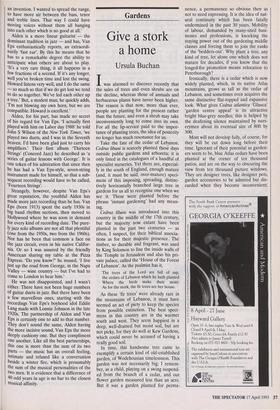Gardens
Give a stork a home
Ursula Buchan
Iwas alarmed to discover recently that the sales of trees and even shrubs are on the decline, whereas those of annuals and herbaceous plants have never been higher. The reason is that now, more than ever, people are planting for the present rather than the future, and even a shrub may take inconveniently long to come into its own. For all the lip-service paid to the impor- tance of planting trees, the idea of posterity no longer has much resonance for us.
Take the fate of the cedar of Lebanon. Cedrus libani is scarcely planted these days outside public gardens and arboreta; it is only listed in the catalogues of a handful of specialist nurseries. Yet there are, especial- ly in the south of England, enough mature (and, it must be said, over-mature) speci- mens of this imposing, spreading, distinc- tively horizontally branched large tree in gardens for us all to recognise one when we see it. These were planted before the phrase 'instant gardening' had any mean- ing, Cedrus libani was introduced into this country in the middle of the 17th century, but the majority now extant have been planted in the past two centuries — as often, I suspect, for their biblical associa- tions as for their majestic presence. The timber, so durable and fragrant, was used by King Solomon to line the inside walls of the Temple in Jerusalem and also his pri- vate palace, called the 'House of the Forest of Lebanon'. As the psalmist has it,
The trees of the Lord are full of sap, the cedars of Lebanon which he hath planted Where the birds make their nests: As for the stork, the fir trees are her house.
As these 'fir trees' were already rare in the mountains of Lebanon, it must have seemed an act of piety to keep the species from possible extinction. The best speci- mens in this country are in the warmer south and west. They seem happiest in a deep, well-drained but moist soil, but are not picky, for they do well at Kew Gardens, which could never be accused of having a really good soil. In time, this handsome tree came to exemplify a certain kind of old-established garden, of Wodehousian timelessness. This garden was not necessarily big; I remem- ber, as a child, playing on a swing suspend- ed from the branch of a cedar, and our flower garden measured less than an acre. But it was a garden planted for perma- nence, a permanence so obvious then as not to need expressing. It is the idea of nat- ural continuity which has been fatally undermined in the past 30 years. Mobility of labour, demanded by many-sited busi- nesses and professions, is knocking the staying power out of the gardening middle classes and forcing them to join the ranks of the tedders-out'. Why plant a tree, any kind of tree, let alone one which does not mature for decades, if you know that the longed-for promotion means relocation to Peterborough?
Ironically, there is a cedar which is now widely planted, which, in its native Atlas mountains, grows as tall as the cedar of Lebanon, and sometimes even acquires the same distinctive flat-topped and expansive look. What gives Cedrus atlantica 'Glauca' `garden centre appeal' is its attractive bright blue-grey needles; this is helped by the deafening silence maintained by nurs- erymen about its eventual size of 80ft by 30ft.
Most will not develop fully, of course, for they will be cut down long before their time. Ignorant of their potential as garden- ers seem to be, blue Atlas cedars have been planted at the corner of ten thousand patios, and are on the way to obscuring the view from ten thousand picture windows. They are designer trees, like designer pets, garden accessories to be admired but dis- carded when they become inconvenient; they will never know a rickety and individu- alistic old age.
Cedars were hit, along with all other trees, by the ferocious gales of 1987 and 1990; unlike other trees, however, there seems to have been little impetus to replant them. Certainly, in private gardens which can still boast a substantial tree, it is rare to see a small specimen planted nearby against the day when it finally dies. (The situation is most hopeful in public gardens, not surprisingly; the National Trust, for example, has a programme of planned replacement.) Yet, with careful siting, many gardens, particularly country ones (as this tree is sensitive to atmospheric pollu- tion) could accommodate one at the far end of the lawn. After all, the roots do not quest inordinately after underground water supplies, like the willow or poplar, which are both common in medium-sized gar- dens, and they are no more prone to wind- blow than other conifers.
Moreover, if you plant one of these truly distinguished trees, not only will you have done your part for posterity, but you may encourage a stork to come to nest in its branches. Well, you never know.



















































 Previous page
Previous page